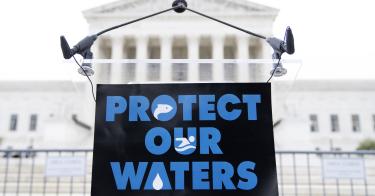Michael and Chantell Sackett have waited for well over a decade to learn whether the federal government would allow them to build a home on land they own. (Yes, you read that correctly.)
How is that possible in America? That’s easy. America might be “the land of the free” and “the home of the brave” in the national anthem, but it’s in the stranglehold of the administrative state everywhere else.
“Land” and “water” might be different to most people. Indeed, we have it on good, long-standing authority that they are and that their separate nature is “good.” Just read Genesis 1:9-10 (King James Version: “And God said, ‘Let the waters under the heaven be gathered together unto one place, and let the dry land appear’ and it was so. And God called the dry land Earth; and the gathering together of the waters He called the Seas, and God saw that it was good.”)
The Environmental Protection Agency and U.S. Army Corps of Engineers mustn’t have read that. They claimed that the Sacketts’ land in Idaho is actually a “water of the United States” under the Clean Water Act, even though their land is not connected to an ocean, lake, river, or stream. Only a lawyer (or maybe a heathen) could make that argument.
The Sacketts wanted to build a home on land that was not on or touching water. The federal government claimed that the Sacketts needed a permit, however, because disrupting the land on their homesite might affect a “water of the United States.”
Fortunately, five justices of the U.S. Supreme Court found Genesis persuasive and ruled Thursday in favor of the Sacketts in Sackett v. Environmental Protection Agency.
In His response to today’s opinion for those in the Great Beyond, God likely wrote: “And it was good.”
In an opinion for five members of the court, Justice Samuel Alito—joined by Chief Justice John Roberts and Justices Clarence Thomas, Neil Gorsuch, and Amy Coney Barrett—concluded that the term “waters of the United States” in the Clean Water Act refers only to the following: (1) geographical features that “in ordinary parlance” would be described as oceans, lakes, rivers, and streams, and (2) adjacent wetlands that are, practically speaking, “indistinguishable” from those bodies of water because of a continuous surface connection with them.
Relying heavily on the Clean Water Act’s text and the common understanding of the terms “waters” and “navigable,” the majority concluded that the term “waters” reached only relatively permanent, standing, or continuously flowing bodies of water forming what in ordinary parlance are oceans, lakes, rivers, and streams.
The majority rejected the government’s interpretation because it would have required every body of water, however small or isolated, to be evaluated whether it is a Clean Water Act-covered “water.”
The other four justices agreed with the majority that the Sacketts’ land was not a “water.” (Whew! Common sense unanimously prevails.) But they would have left room for wetlands in the vicinity of oceans, lakes, rivers, and streams to qualify as “waters” in other cases.
How did this happen? How could the Sacketts’ case have taken two trips to the Supreme Court and two sets of opinions to resolve what, on its face, should have been an easy issue?
The answer, ironically, is rather simple. Two factors came together to make the Sacketts endure the trials of Job to be able to avoid $40,000 per day fines for what was once thought of as the American dream; namely, building a home on land you own.
First, Congress did not define the terms “navigable waters” and “waters of the United States” with the specificity necessary to prevent lawyers from turning this case into an environmental Jarndyce v. Jarndyce of Charles Dickens’ “Bleak House” fame. (The latter has become a literary metaphor for seemingly interminable legal proceedings.)
Maybe Congress thought that those terms needed no further explication. That’s what Thomas, in a separate opinion joined by Gorsuch, thought.
Maybe the members of Congress decided to punt the interpretive problem to the courts to avoid having to negotiate and debate the issue. That’s a common problem with Congress today. Whatever the reason, agencies and their lawyers committed to environmentalism uber alles were able to muck up the Sacketts’ dream for 10-plus years.
Second, the EPA and the Army Corps of Engineers approached this issue with an environmental engineering mindset. They asked themselves, “How can we ensure that every actual and potential body of water, wetland, or even dry land that yearns to be wet can fall under the Clean Water Act?”
“That’s easy,” they concluded. “Just make any body of water or parcel of land that has any hydrological connection to a lake or river a ‘water of the United States.’”
The effect was to examine the issue not as a matter of deciding what water bodies can be navigated from one state to another, which was the approach that Thomas and Gorsuch found critical.
No, if H2O goes from Water Body A to Water Body/Land Parcel B, then the latter is a Clean Water Act-covered water. How can we know whether that transfer does or can occur? Again, the EPA and Army Corps concluded, “That’s easy. Just ask us, or hire your own expert hydrologists, botanists, biologists, or whatever-ists.”
Then, perhaps a decade later—and/or your wallet $50,000 to $100,000 lighter—you might know.
That’s nonsense, as the Alito majority rightly noted. The law is not always sane, but the Supreme Court surely was Thursday.
This piece originally appeared in The Daily Signal





